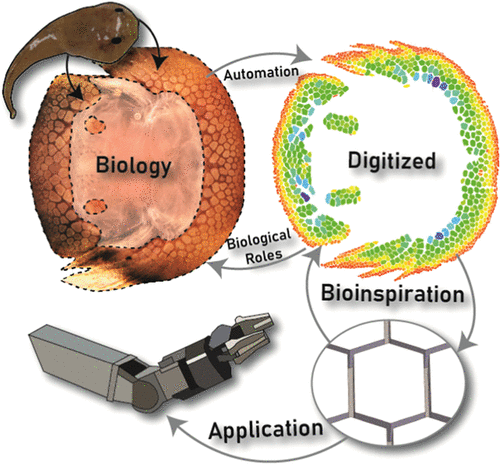当前位置:
X-MOL 学术
›
ACS Appl. Mater. Interfaces
›
论文详情
Our official English website, www.x-mol.net, welcomes your feedback! (Note: you will need to create a separate account there.)
Toward Bioinspired Wet Adhesives: Lessons from Assessing Surface Structures of the Suction Disc of Intertidal Clingfish.
ACS Applied Materials & Interfaces ( IF 9.5 ) Pub Date : 2020-09-10 , DOI: 10.1021/acsami.0c10749 Jessica A Sandoval 1 , Jade Sommers 2 , Karthik R Peddireddy 3 , Rae M Robertson-Anderson 3 , Michael T Tolley 4, 5 , Dimitri D Deheyn 6
ACS Applied Materials & Interfaces ( IF 9.5 ) Pub Date : 2020-09-10 , DOI: 10.1021/acsami.0c10749 Jessica A Sandoval 1 , Jade Sommers 2 , Karthik R Peddireddy 3 , Rae M Robertson-Anderson 3 , Michael T Tolley 4, 5 , Dimitri D Deheyn 6
Affiliation

|
The clingfish attaches to rough surfaces with considerable strength using an intricate suction disc, which displays complex surface geometries from structures called papillae. However, the exact role of these structures in adhesion is poorly understood. To investigate the relationship between papillae geometry and adhesive performance, we developed an image processing tool that analyzed the surface and structural complexity of papillae, which we then used to model hydrodynamic adhesion. Our tool allowed for the automated analysis of thousands of papillae in specimens across a range of body sizes. The results led us to identify spatial trends in papillae across the complex geometry of the suction disc and to establish fundamental structure–function relationships used in hydrodynamic adhesion. We found that the surface area of papillae changed within a suction disc and with fish size, but that the aspect ratios and channel width between papillae did not. Using a mathematical model, we found that the surface structures can adhere considerably when subjected to disturbances of moderate to high velocities. We concluded that a predominant role of the papillae is to leverage hydrodynamic adhesion and wet friction to reinforce the seal of the suction disc. Overall, the trends in papillae characteristics provided insights into bioinspired designs of surface microstructures for future applications in which adhesion is necessary to attach to diverse surfaces (in terrestrial or aquatic environments), even when subjected to disturbance forces of randomized directionality.
中文翻译:

迈向生物启发的湿粘合剂:潮间带鱼肉吸盘表面结构评估的经验教训。
缠鱼使用复杂的吸盘以相当大的强度附着在粗糙表面上,该吸盘显示出称为乳头状结构的复杂表面几何形状。但是,人们对这些结构在粘附中的确切作用了解甚少。为了研究乳头几何形状与粘附性能之间的关系,我们开发了一种图像处理工具,用于分析乳头的表面和结构复杂性,然后将其用于对流体动力粘附进行建模。我们的工具可以对各种体型的标本中的数千个乳头进行自动分析。结果使我们确定了吸盘复杂几何形状中乳头的空间趋势,并建立了用于流体动力粘附的基本结构-功能关系。我们发现,乳头的表面积在吸盘内随鱼的大小而变化,但是乳头之间的纵横比和通道宽度没有变化。使用数学模型,我们发现,表面结构在受到中等到高速的干扰时会粘附很多。我们得出的结论是,乳头的主要作用是利用流体动力粘附力和湿摩擦力来增强吸盘的密封性。总体而言,乳头状特征的趋势为将来的应用提供了对表面微观结构的生物启发设计的见解,在将来的应用中,即使受到随机方向性的干扰力,也必须将附着力附着到不同的表面上(在陆地或水生环境中)。但乳突之间的长宽比和通道宽度却没有。使用数学模型,我们发现,表面结构在受到中等到高速的干扰时会粘附很多。我们得出的结论是,乳头的主要作用是利用流体动力粘附力和湿摩擦力来增强吸盘的密封性。总体而言,乳头状特征的趋势为将来的应用提供了对表面微观结构的生物启发设计的见解,在将来的应用中,即使受到随机方向性的干扰力,也必须将附着力附着到不同的表面上(在陆地或水生环境中)。但乳突之间的长宽比和通道宽度却没有。使用数学模型,我们发现,表面结构在受到中等到高速的干扰时会粘附很多。我们得出的结论是,乳头的主要作用是利用流体动力粘附力和湿摩擦力来增强吸盘的密封性。总体而言,乳头状特征的趋势为将来的应用提供了对表面微观结构的生物启发设计的见解,在将来的应用中,即使受到随机方向性的干扰力,也必须将附着力附着到不同的表面上(在陆地或水生环境中)。我们发现,当受到中等到高速的干扰时,表面结构可以粘附很多。我们得出的结论是,乳头的主要作用是利用流体动力粘附力和湿摩擦力来增强吸盘的密封性。总体而言,乳头状特征的趋势为将来的应用提供了对表面微观结构的生物启发设计的见解,在将来的应用中,即使受到随机方向性的干扰力,也必须将附着力附着到不同的表面上(在陆地或水生环境中)。我们发现,当受到中等到高速的干扰时,表面结构可以粘附很多。我们得出的结论是,乳头的主要作用是利用流体动力粘附力和湿摩擦力来增强吸盘的密封性。总体而言,乳头状特征的趋势为将来的应用提供了对表面微观结构的生物启发设计的见解,在将来的应用中,即使受到随机方向性的干扰力,也必须将附着力附着到不同的表面上(在陆地或水生环境中)。
更新日期:2020-10-07
中文翻译:

迈向生物启发的湿粘合剂:潮间带鱼肉吸盘表面结构评估的经验教训。
缠鱼使用复杂的吸盘以相当大的强度附着在粗糙表面上,该吸盘显示出称为乳头状结构的复杂表面几何形状。但是,人们对这些结构在粘附中的确切作用了解甚少。为了研究乳头几何形状与粘附性能之间的关系,我们开发了一种图像处理工具,用于分析乳头的表面和结构复杂性,然后将其用于对流体动力粘附进行建模。我们的工具可以对各种体型的标本中的数千个乳头进行自动分析。结果使我们确定了吸盘复杂几何形状中乳头的空间趋势,并建立了用于流体动力粘附的基本结构-功能关系。我们发现,乳头的表面积在吸盘内随鱼的大小而变化,但是乳头之间的纵横比和通道宽度没有变化。使用数学模型,我们发现,表面结构在受到中等到高速的干扰时会粘附很多。我们得出的结论是,乳头的主要作用是利用流体动力粘附力和湿摩擦力来增强吸盘的密封性。总体而言,乳头状特征的趋势为将来的应用提供了对表面微观结构的生物启发设计的见解,在将来的应用中,即使受到随机方向性的干扰力,也必须将附着力附着到不同的表面上(在陆地或水生环境中)。但乳突之间的长宽比和通道宽度却没有。使用数学模型,我们发现,表面结构在受到中等到高速的干扰时会粘附很多。我们得出的结论是,乳头的主要作用是利用流体动力粘附力和湿摩擦力来增强吸盘的密封性。总体而言,乳头状特征的趋势为将来的应用提供了对表面微观结构的生物启发设计的见解,在将来的应用中,即使受到随机方向性的干扰力,也必须将附着力附着到不同的表面上(在陆地或水生环境中)。但乳突之间的长宽比和通道宽度却没有。使用数学模型,我们发现,表面结构在受到中等到高速的干扰时会粘附很多。我们得出的结论是,乳头的主要作用是利用流体动力粘附力和湿摩擦力来增强吸盘的密封性。总体而言,乳头状特征的趋势为将来的应用提供了对表面微观结构的生物启发设计的见解,在将来的应用中,即使受到随机方向性的干扰力,也必须将附着力附着到不同的表面上(在陆地或水生环境中)。我们发现,当受到中等到高速的干扰时,表面结构可以粘附很多。我们得出的结论是,乳头的主要作用是利用流体动力粘附力和湿摩擦力来增强吸盘的密封性。总体而言,乳头状特征的趋势为将来的应用提供了对表面微观结构的生物启发设计的见解,在将来的应用中,即使受到随机方向性的干扰力,也必须将附着力附着到不同的表面上(在陆地或水生环境中)。我们发现,当受到中等到高速的干扰时,表面结构可以粘附很多。我们得出的结论是,乳头的主要作用是利用流体动力粘附力和湿摩擦力来增强吸盘的密封性。总体而言,乳头状特征的趋势为将来的应用提供了对表面微观结构的生物启发设计的见解,在将来的应用中,即使受到随机方向性的干扰力,也必须将附着力附着到不同的表面上(在陆地或水生环境中)。



























 京公网安备 11010802027423号
京公网安备 11010802027423号